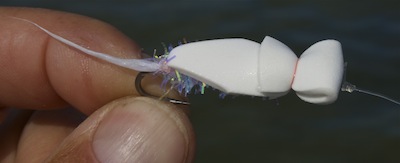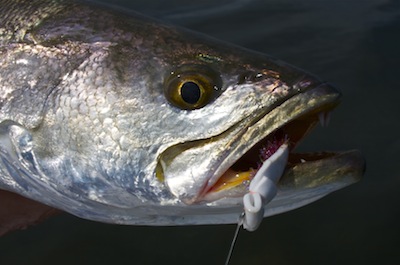In my last fishing report I mentioned using the late Jack Gartside’s Gurgler for seatrout with great success. I went to Jack’s website (yes, it’s still up and running, you can see it here) to see if I tied it anything remotely like Jack did. It’s modified quite a bit. I suppose that’s to be expected. Fly tyers always modify stuff to fit their own needs.
You tie these in the sizes and colors you need to match what your intended target is. For the seatrout I tie it as below, in white. I tie it on a #4 Gamakatsu SC-15 for baby tarpon. I use it in Alaska as tied below, but in pink, for silver salmon and on a #6 long shank hook in orange for Dolly varden. I tie little ones for bluegills. It’s a wonderfully versatile pattern.
Here’s how I tie it. Fishing instructions are below.
Hook- Mustad 34011, size 2
Thread- flat waxed nylon
Tail- short piece of calftail, marabou, or Arctic fox
Body- Estaz or similar material
“Shell”- craft foam cut to about a 1/4-3/8th inch width.
1) Start the thread and wind back to hook bend. Tie in the tail. I find a short tail fouls much less frequently than a long one.
2) Tie in the Estaz, same spot.
3) Take the strip of craft foam and your scissors and taper the end to a “V.” Tie in the point of the V such that the strip extends out over the tail.
4) Wrap the thread up to a point about 1/4 inch behind the eye of the hook. Wrap the Estaz to that point. Tie it off and cut it.
5) Fold the foam over and tie it off at the same point.
6) Fold the foam back on itself and tie it off again, at the same point. The foam is now two layers thick. Drop the bobbin and use the scissors to cut the foam off 1/4 inch behind where you tied it off. The doubled foam increases the fly’s buoyancy, and makes it somewhat more durable.
7) Whip the head, then cement it.
When fishing for seatrout I try to make the fly pop and spit water. It does not make the commotion a popper will but it seems to make quite enough for the trout.
In Alaska when fishing silvers I fish it the same way.
For dollies cast it quartering downstream and give it little pops as it swings. There is no more enjoyable way of catching them.
Please let me know how it works for you.
John Kumiski
http://www.spottedtail.com
All content in this blog, including writing and photos, copyright John Kumiski 2012. All rights are reserved.
|



Recent Comments